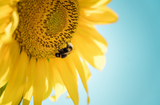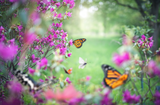
How To Build A Bee and Butterfly Friendly Garden With Children
Out of all of the activities we do with children, the ones that help them to understand the wonderful world they live in are by far the best. Bee and butterfly-friendly gardens are not only great for nature, and therefore the planet, but they are also joyful to create.
Why are bees and butterflies good for the environment?
Bees and butterflies are vital to our ecosystem. Both get their food from plants

and, in return, they act as pollinators. Bees and butterflies unwittingly collect pollen as they investigate flowers and as they fly to their next destination, pollen is usually cast off, falling to the ground where a new flower can grow. The pollen needs to fall away from the mother plant to avoid them competing for nutrients. This process also encourages biodiversity which is good for plants because, with different species to feed, the soil remains diverse, keeping it nutritionally rich and better able to support life.
How does biodiversity help humans? We need a variety of plants and animals to sustain us. For food, but also to keep our atmosphere balanced, being that plants absorb carbon dioxide and provide us with essential oxygen.
Bees and butterflies are essential for plants and vice versa. This relationship protects a much larger ecosystem that must remain healthy. Not least because human beings are also a part of this delicate ecosystem and just as reliant on each part thriving.
Why are bees and butterflies declining?
One out of ten bee and butterfly species in Europe is under threat of extinction.

This might not sound too concerning but consider that that means 10%. If 10% disappears then 10% of plant populations will follow and a domino effect may begin to take hold. A serious decline in the bee and butterfly population may mean less variety on our supermarket shelves.
Bees and butterflies are under threat for a number of reasons. As the human population spreads and becomes denser, more and more green spaces disappear. Even a protected countryside is not enough. We need to bring bees and butterflies back to our gardens, even if our gardens are small. Even if they’ve already been concreted over. Of course, some of us are lucky enough to have great big gardens with plenty of space for planting, but many of us are living in apartments or with courtyard patios. No matter our circumstances there is always something we can do to help bees and butterflies flourish. We just need to get a bit creative.
Here is how to build a bee and butterfly friendly garden with the kids and also some ideas of what you can do if you don’t have a garden:
Building a bee and butterfly garden with children
Making your green space insect-friendly is a lovely activity to do with children. It helps with their understanding of the world and our individual and collective

responsibility to protect our planet. Besides, being outdoors in nature as a family is healthy and wonderful for wellbeing. It’s also a low-cost activity for a Spring or Summer day.
To attract bees and butterflies to your garden you will need flowers, as many as possible. Some are more appealing to our colourful flying friends than others and there are many other factors to consider including where they are planted and when. Here are our top tips for creating a bee and butterfly friendly garden with the kids:
Variety Is Key - Flowers are experts at attracting the right pollinators but to keep things diverse a good mix of plants is best. Aside from being most attractive and more fun to watch take bloom, they’ll also open at different times throughout the year keeping your garden insect-friendly all year round. A variety of flowers also brings a variety of pollinators.
Plant Densely - Make it easy for bees and butterflies to find flowers by planting them in clumps as opposed to widely spread out. If you’ve ever seen a bee bumble around you’ll concede that flying is not their strong point and you’ll do them a great service by not giving them too far to travel.
Shallow Water - It’s easy to forget about water, but bees and butterflies need this too. The key is to ensure that standing water isn’t presenting a drowning risk. A little water with pebbles thrown in to provide perches for flying insects is ideal. Children will love placing a little water in a tray and scattering pebbles inside to create a little bee and butterfly waterhole.
Seed Bombs - Seed bombs are an easy, fun and effective way of planting a wide variety of wildflowers in one place. Each bom contains an array of wildflower seeds and all you need do is pull the pin and throw it into an area of your garden you’d like to see more flowers. The seed bom will biodegrade leaving the seeds to spread and settle. We stock Bee Bom Seed Bombs, ButterflyBom SeedBom or go all our with the Bird, Bee and Butterfly Gift Set.
Hanging Baskets - These are particularly useful for those who don’t have gardens but they’re also good fun to plant up with the kids. Buying plug plants mean an instant result which is far more satisfying for children than waiting for seeds to emerge. Plus, if you hang yours by your front door then every day you can inspect the basket for new blooms. Hanging baskets are also easier for bees and butterflies to get to and provide some protection for them too.
Consider A Mini Meadow - A little rewilding will do wonders for the bees and the butterflies. If you’re fortunate enough to have a medium to large space then perhaps a section of your garden can be left to thrive alone. With children, you’ll probably want a cut lawn where the kids can run around and perhaps where you can even have play equipment. However, it may not be necessary to cut the grass at the back of the garden. Leaving just a strip for the grass to grow long can create a perfect home for a thriving ecosystem.
Be Hands-Off - Once you have done your planting try to leave your garden alone. Perennial flowers that attract butterflies and bees don’t need a lot of tending to, that’s why they’re called wildflowers. Wildflowers and pollinators will take care of one another, just as they do in the countryside. Too much gardening and desire for neatness is what has spurred a decline in the wildflower and pollinator populations. Don’t be afraid to rewild a little, even if it’s just a section of your garden.
How to keep children engaged when gardening
Including children in the whole experience will help acquire their interest. They

should be involved from the point of selecting the seeds or plug plants. They’ll love going to get the plants, looking at the seed packers and helping to choose.
The key to keeping the children interested in the actual planting is not to drag it out too long. Planting should be an exciting experience and so get out, get a bit muddy and get those plants in. SeedBoms are an ideal way to do them and a big hit with the kids.
There’s also much fun to be had after the planting when the flowers begin to

bloom and you can all have fun spotting the bees and butterflies. Don’t be too put off if they don’t arrive immediately. It can take a little while to be found, especially if you’re in a built-up area, but that’s what makes it even more important.
The best way to ensure children are not afraid of the environmental problem we’re facing is to empower them to be part of the change. Let them help to make a real difference, literally on their own doorstep.
Head to the Royal Horticultural Society website to find out which plants and flowers are best for attracting bees and butterflies.
